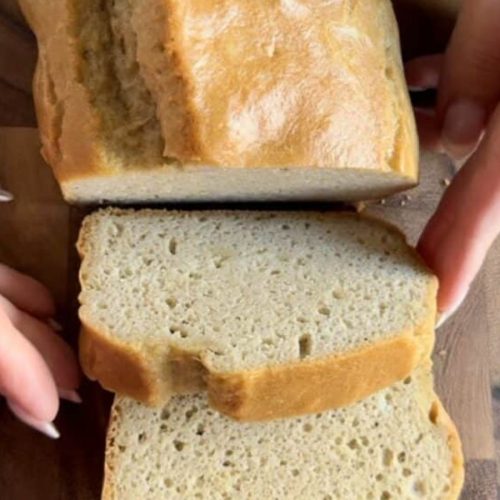
Almond Flour Bread
A quick and easy almond flour bread that’s soft, flavorful, and perfect for everyday use. Gluten-free, low in carbs, and rich in protein and healthy fats, this loaf is ideal for sandwiches, toast, or meal prep.
Equipment
- 1 8×4 inch loaf pan
- 1 large mixing bowl
- 1 Whisk
Ingredients
- 5 large eggs
- 5 tbsp olive oil or melted butter/coconut oil
- 1 tbsp maple syrup
- 1 tsp apple cider vinegar or white wine vinegar
- 1 ¾ cups super-fine almond flour
- ½ tsp baking soda
- ¼ tsp salt
Instructions
- Preheat & Prepare the Pan: Set the oven to 350°F (175°C). Line an 8×4-inch (20×10 cm) loaf pan with a sling of parchment paper so it overhangs the long sides; lightly grease the exposed ends of the pan. This prevents sticking and makes lifting the loaf out seamless.
- Gather & Temperature-Check Ingredients: Bring the eggs and oil to room temperature if possible (10–15 minutes on the counter). Room-temp ingredients blend more evenly and help the loaf rise uniformly.
- Beat the Eggs Lightly: Crack 5 eggs into a large mixing bowl. Whisk just until the whites and yolks are fully combined and slightly frothy—about 20–30 seconds. You’re aiming for a uniform mixture, not volume.
- Whisk in the Liquids for Emulsion: Add 5 tbsp olive oil (or melted butter/coconut oil), 1 tbsp maple syrup, and 1 tsp apple cider vinegar to the eggs.Whisk until the mixture looks smooth and glossy. The vinegar is essential—it reacts with the baking soda to create lift, so don’t skip it.
- Combine Dry Ingredients Separately: In a medium bowl, whisk together 1¾ cups super-fine almond flour, ½ tsp baking soda, and ¼ tsp salt. Breaking up any almond-flour clumps now prevents pockets of dry mix later.
- Incorporate Dry into Wet Slowly: Sprinkle the dry mixture over the wet base in two to three additions. After each addition, whisk or stir with a spatula until no streaks remain. The batter should be thick, scoopable, and cohesive.
- Final Batter Check & Rest (Optional): Scrape the bowl’s sides and bottom to catch hidden pockets of flour. If your almond flour was very cold, let the batter sit 2–3 minutes; this brief rest helps hydrate the flour and evens the texture.
- Pan the Batter Cleanly: Transfer the batter to the prepared loaf pan. Use a spatula to spread it into the corners and level the top. Smooth, even thickness supports consistent rise.
- Level, Tap & Vent: Gently tap the pan on the counter 2–3 times to release large air bubbles. Use the spatula to create a very shallow trench down the center—this encourages an attractive, controlled split as it bakes.
- Bake to Golden: Place the pan on the middle rack and bake 30–35 minutes. The top should turn evenly golden and spring back lightly when touched.
- Check for Doneness: Insert a toothpick or thin skewer into the center; it should come out clean or with a few moist crumbs (no wet batter). If you use a thermometer, the center should read about 200°F (93°C). If the top browns too fast, tent loosely with foil for the last few minutes.
- Cool Briefly in the Pan: Set the pan on a rack and cool for 10 minutes. This short rest allows the structure to set so the loaf unmolds without tearing.
- Lift, Unmold & Finish Cooling: Use the parchment overhang to lift the loaf onto the rack. Peel back the parchment and cool an additional 20 minutes before slicing; cutting too soon can compress the crumb.
- Slice for Best Texture: Use a sharp, serrated knife to slice to your preferred thickness. For clean slices, saw gently rather than pressing straight down.
- Serve Creatively: Enjoy as sandwich bread, topped with avocado, or simply warm with a swipe of butter and a drizzle of honey. Light toasting brings out a lovely nutty aroma.
- Store & Reheat Like a Pro: Keep leftovers in an airtight container in the fridge for several days. For longer storage, slice the loaf, wrap well, and freeze; toast slices straight from frozen or thaw briefly, then toast to revive the just-baked texture. You may substitute white wine vinegar for apple cider vinegar if needed.
Notes
- Use super-fine almond flour for the best texture—coarser flour makes the bread grainy.
- The apple cider vinegar is crucial—it activates the baking soda for lift.
- Don’t overmix the batter; stir just until combined to keep the bread soft.
- A parchment sling makes removing the loaf much easier.
- For extra flavor, try adding herbs, garlic powder, or seeds into the batter.
- Light toasting enhances the bread’s nutty flavor and aroma.
- Slice with a serrated bread knife for clean cuts.
- Store the bread properly to maintain freshness and prevent dryness.